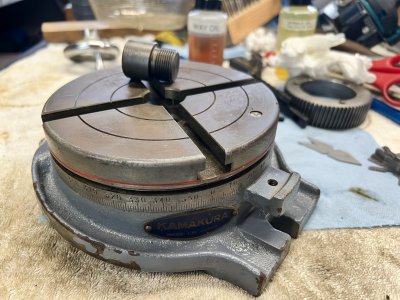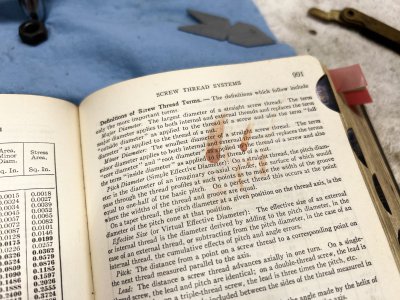- Joined
- Dec 6, 2021
- Messages
- 224
I’m cleaning up an old rotary table I found last year. Though the tag says it was made in Japan, all the screws and clamp handles are SAE thread. (Was that common for Japanese manufacturers in the 50s, 60s and 70s??)
Anyway, it’s the table’s center hole that’s getting my attention. It’s threaded rather than tapered. The plug seats about 60 thou below the surface and seems useful only for blocking chips. I assume if I want any center alignment or fixture pins, I’m going to have to make them. That’s fine, but I need a sanity check trying to ID that thread…
Major dia. is 23.10mm/.9095in. Threads are 60° and a perfect 1.50mm pitch. (18TPI is too small, 16 too large and my Starrett No6 never heard of 17TPI.) I’ll be damned if I can find anything in my 15th ed. MHB or the engineer’s black book with specs like that.
I guess it doesn’t really matter if I’m cutting threads on the lathe. But it’ll be my first threading project and it would be nice to find an actual standard with tolerances. Just want to be sure I’m not overlooking something obvious…
Any help?

Looks like the guy who owned this 15th ed. before me had some difficulty with threads too…

Anyway, it’s the table’s center hole that’s getting my attention. It’s threaded rather than tapered. The plug seats about 60 thou below the surface and seems useful only for blocking chips. I assume if I want any center alignment or fixture pins, I’m going to have to make them. That’s fine, but I need a sanity check trying to ID that thread…
Major dia. is 23.10mm/.9095in. Threads are 60° and a perfect 1.50mm pitch. (18TPI is too small, 16 too large and my Starrett No6 never heard of 17TPI.) I’ll be damned if I can find anything in my 15th ed. MHB or the engineer’s black book with specs like that.
I guess it doesn’t really matter if I’m cutting threads on the lathe. But it’ll be my first threading project and it would be nice to find an actual standard with tolerances. Just want to be sure I’m not overlooking something obvious…
Any help?

Looks like the guy who owned this 15th ed. before me had some difficulty with threads too…


